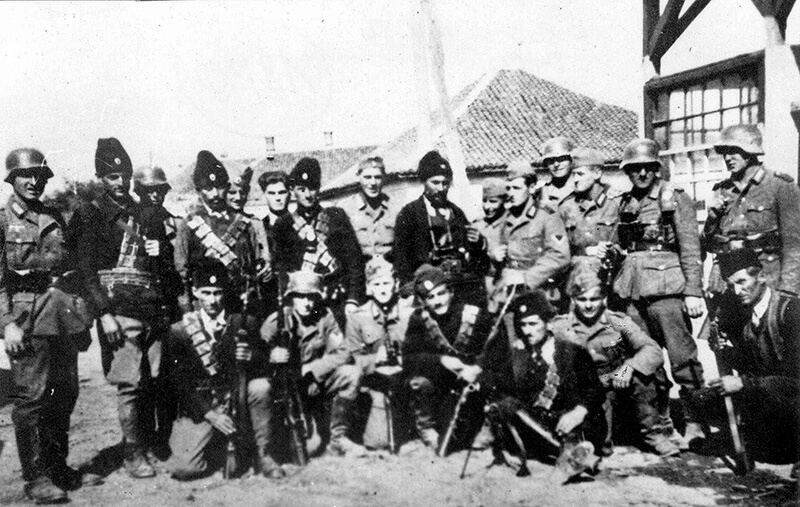| Page Created |
| May 25th, 2022 |
| Last Updated |
| May 25th, 2022 |
| The Axis Special Forces |
| Finland Germany Italy Japan The Soviet Union |
| History |
| The Axis were from the beginning on more organised. This was mainly because all three major players had big expansion plans and were in need of allies. Especially Adolf Hitler was a master in pacts and politics. As early as October 1936 Germany and Italy signed the nine-point or Rome-Berlin pact. One month later Germany signed the Anti-Comintern Pact with Japan. Italy joined this Pact in 1937. Hungary, Manchukuo and Spain in 1939. In that very same year the Rome Berlin pact became a military pact, known as the pact of steel. Also, in 1939 Germany and the Soviet Union signed the Molotov–Ribbentrop Pact. This ensured the Germans that the Soviets wouldn’t attack them while invading Poland and gave the Soviet Union, East Poland. This surprised the Japanese since it conflicted with the Anti-Comintern Pact signed in 1936. To restore the alliance, Germany and Japan signed the Agreement for Cultural Cooperation between Japan and Germany in November 1939. In September 1940 Japan joined the steel pact, now known as the Tripartite Pact. Hungary signed a few days later, shortly followed by the Slovak Republic. The Axis now had a firm base to start the war. on November 17th, 1940, Bulgaria joined the pact followed by Rumania on November 22nd, 1940. When France was forced to sign the armistice in June 1940, the French General Pétain became the leader of the Vichy French. Vichy French wasn’t allowed to keep troops in France but in North Africa they had almost 130,000 troops. Their navy was also fully intact there. Pétain was forced to leave French Indochina to the Japanese. Germany and Italy were allowed to use Vichy French bases in France and North Africa. When the Allied invaded North Africa the autonomy of the Vichy French Army was quickly reduced, and they were only to function under German and Italian leadership. On March 25th, 1941, Yugoslavia signed the pact, leaving it on April 8th, 1941, when Germany invaded the country. The Independent State of Croatia that was created by conquering Yugoslavia signed the pact on June 15th ,1941. A few days later The Axis invaded the Soviet Union effectively ending the pact with Germany, signed in 1939. A few days later Finland attacked the Soviet Union to get back the land they lost in 1939. They never signed a treaty with Germany, but they acted in the thought that the enemy of my enemy is my friend. In 1944 when the alliance had no benefits anymore, they switched back to the Allies. Burma and Thailand signed a treaty with Japan. The government in Burma became more or less a puppet government. The Kingdom of Thailand signed the Greater East Asia Joint Declaration in November 1943, which formalised the pact with The Axis. By the end of the war the Thai people had enough of the Japanese and wit a coup d’etat they overthrew the pro Japanese Government. The last big ally was Iraq. In April 1941, a nationalist group had seized the power in the country. This group was pro Axis. Italian and German Aircraft tried to support them Syria causing Commonweath troops to capture Syria. By the end of May 1941 Iraq was under British control. When the Soviet Union and the United States joined the war. Most of the allies of the Axis had to surrender. Some of them switched sides and fought along the Allied. In September 1943 Italy and Albania joined the Allied, Followed in 1944 by Hungary, Rumania, Bulgaria, and Finland. In the end the tight Alliances of the Axis, created in the early 1939 and 1940, were not strong enough to win the war. |
| The Axis, Part by date of Declarations of War |
 |
| July 7th, 1937 |
| Japan |
| September 1st, 1939 |
| Germany Austria Slovak Republic |
| September 17th, 1939 – June 22nd, 1941 (Switched sides) |
| The Soviet Union |
| June 10th, 1940 – September 8th, 1943 (Switched sides) |
| Italy |
| June 25th, 1940 |
| Vichy France (Puppet Government) |
| April 7th, 1941 – December 28th, 1944 (Switched sides) |
| Hungary |
| May 2nd, 1941 – January 17th, 1943 (Switched sides) |
| Iraq |
| March 25th, 1941 – April 6th, 1941 (Switched sides) |
| Yugoslavia |
| June 22nd, 1941 – August 25th, 1944 (Switched sides) |
| Rumania |
| June 25th, 1941 – September 15th, 1944 (Switched sides) |
| Finland |
| August 25th, 1941 – September 9th, 1943 (Switched sides) |
| Iran |
| December 7th, 1941 |
| Japan |
| December 8th, 1941 |
| Manchukuo |
| December 12th, 1941 – September 8th, 1944 (Switched sides) |
| Bulgaria |
| December 14th, 1941 |
| Independent State of Croatia |
| December 17th, 1941 – September 8th, 1943 (Switched sides) |
| Albania |
| January 25th, 1942 |
| Thailand |
| January 9th, 1943 |
| Reorganized National Government of China (Puppet Government) |
| August 1st, 1943 |
| State of Burma (Puppet Government) |

